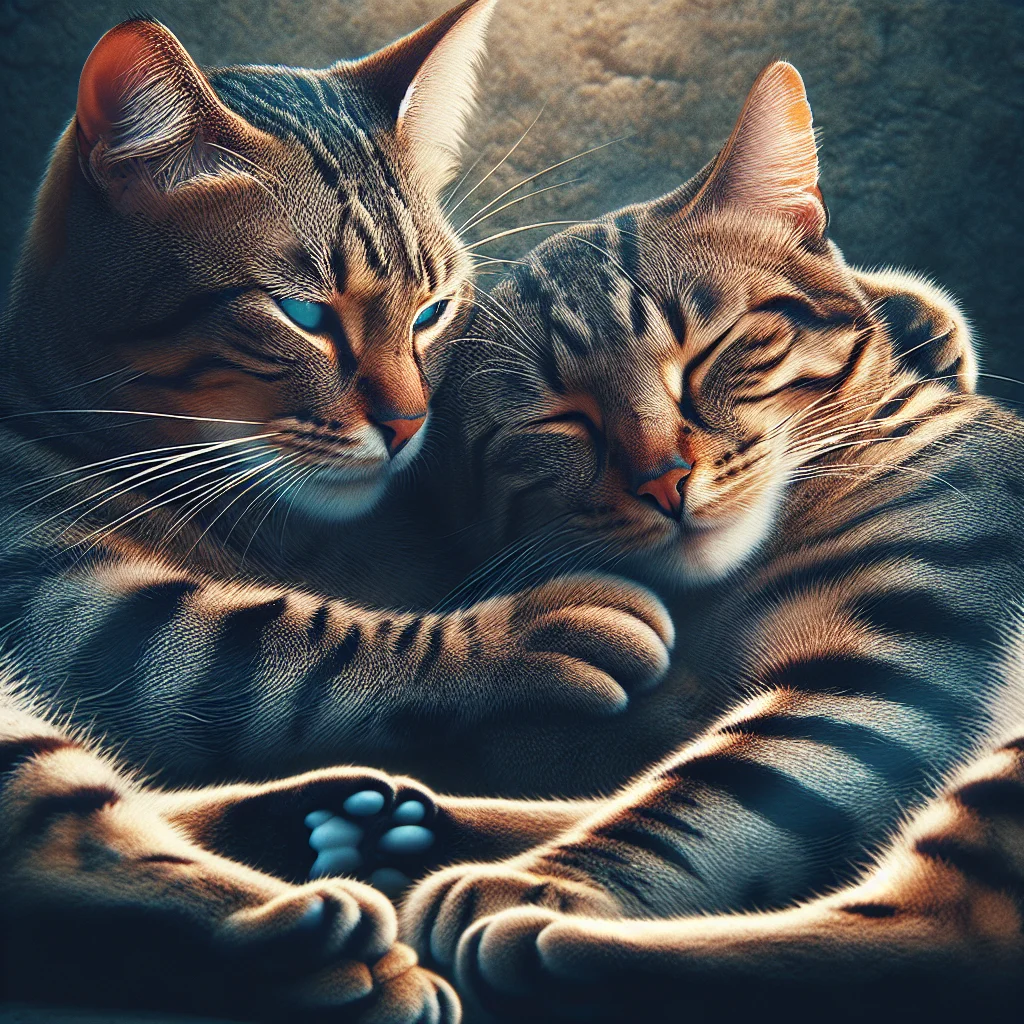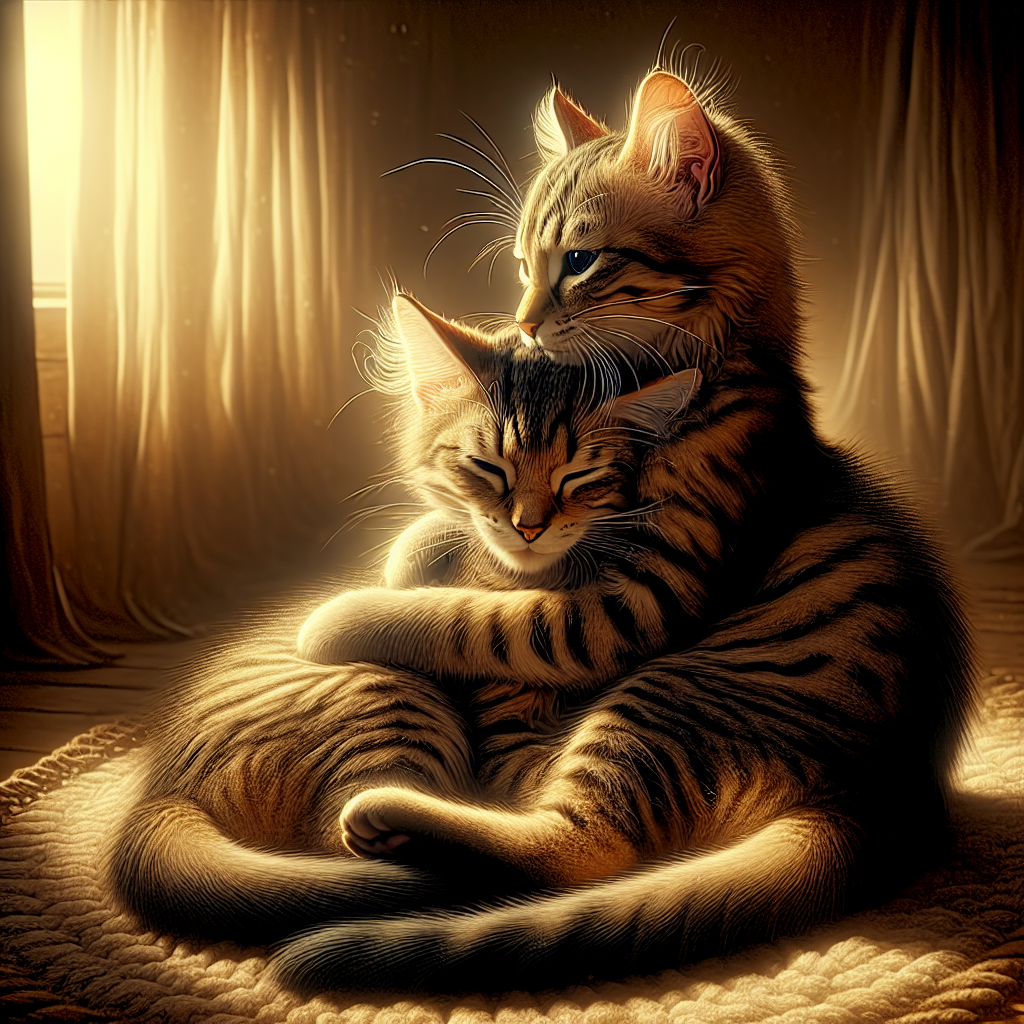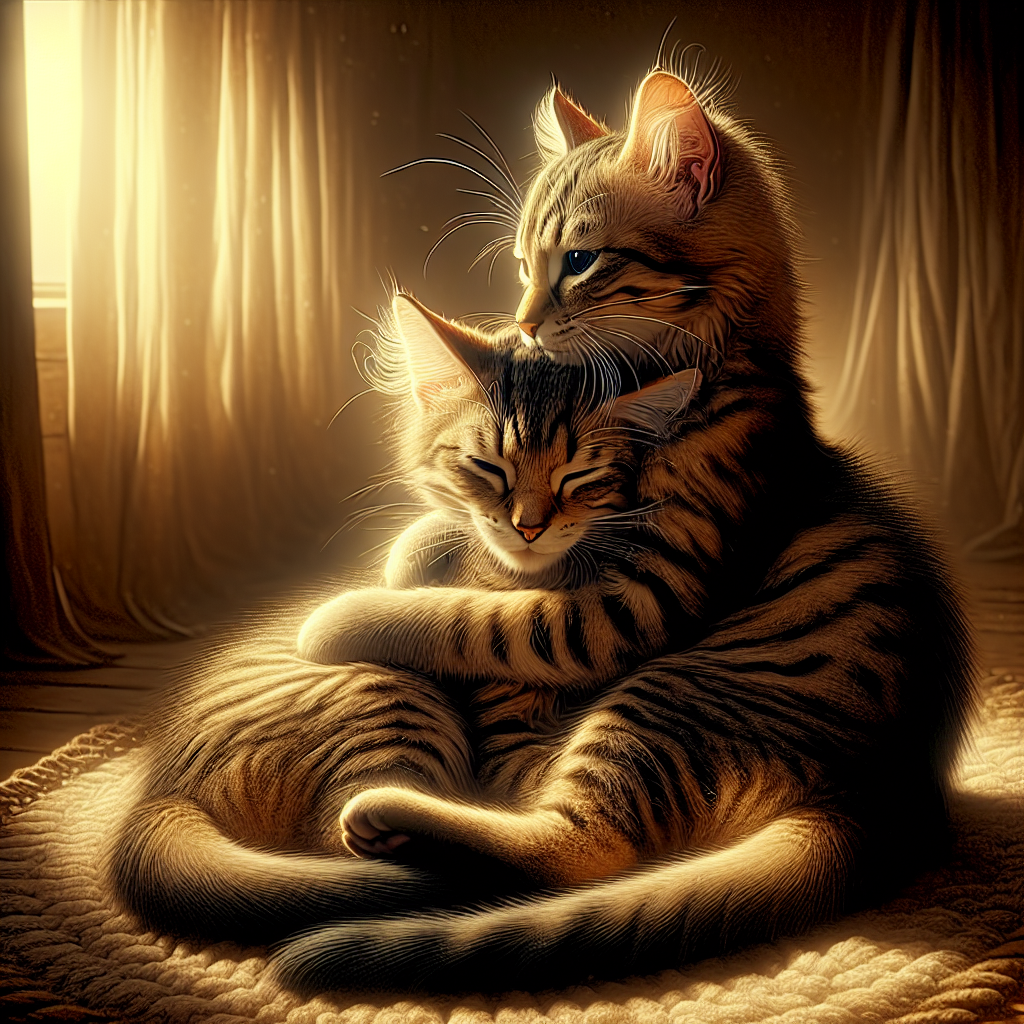Are tiger tabby cats friendly to other cats? If you’ve ever wondered about the social behaviors of these majestic felines, you’re in for a treat. Despite their striking appearance and wild ancestry, tiger tabby cats are known for their friendly and sociable nature. Whether they’re sharing their homes with other cats or encountering unfamiliar feline friends, tiger tabbies often exhibit a remarkable camaraderie. In this article, we’ll explore the various factors that contribute to their amiable personalities, shedding light on how they interact with their fellow furry companions. So, if you’re ready to uncover the secrets behind their social skills, let’s embark on a captivating journey into the world of tiger tabby cats.

Physical Characteristics of Tiger Tabby Cats
Coat Pattern and Color
Tiger tabby cats are known for their distinctive coat pattern, which resembles the stripes of a tiger. This pattern is characterized by bold, dark stripes that run vertically along the body, with a lighter background color. The color variations can range from brown, gray, and orange to silver, blue, and cream. In addition to the striped pattern, some tiger tabbies may also have spots or patches on their coat.
Body Size and Shape
In terms of body size and shape, tiger tabby cats generally have a medium to large build. They have muscular bodies with strong bones, enabling them to exhibit athleticism and grace. Their body shape is typically lean and well-proportioned, with a solid frame that allows for agility and flexibility. These physical characteristics make tiger tabbies well-suited for activities such as climbing, jumping, and pouncing.
Facial Features
Tiger tabby cats have a unique combination of facial features that contribute to their charismatic appearance. They often have round or slightly oval-shaped eyes, which can come in various colors, including green, amber, or yellow. Their ears are medium-sized and pointed, adding to their alert expression. Additionally, tiger tabbies may have a prominent, triangular-shaped head and a well-defined muzzle. These facial features give them an endearing and slightly wild look.
Understanding Cat Behavior
Social Nature of Cats
Cats, including tiger tabby cats, are social animals. While they may not have the same social structure as dogs or humans, they still crave and benefit from social interactions. Cats establish relationships with other cats through various forms of communication, such as scent marking, body language, and vocalizations. They engage in activities like grooming, playing, and even sleeping together, forming bonds within their feline community.
Territorial Instincts
Like most cats, tiger tabby cats have a strong territorial instinct. They mark their territory by rubbing their scent glands against objects or by scratching surfaces with their claws. This behavior helps them establish a sense of ownership and security in their environment. When introducing a new cat, understanding their territorial instincts is crucial to ensure a smooth transition and minimize potential conflicts.
Hierarchy and Dominance
Within a multi-cat household, a hierarchy and dominance structure may develop among the cats, including tiger tabbies. Cats establish their positions through subtle cues, such as body posture, vocalizations, and assertive behaviors. It’s essential to recognize and respect this hierarchy to prevent tension or aggression. Providing adequate resources and space for each cat can help maintain a harmonious dynamic among them.
Factors Affecting Cat Friendliness
Early Socialization
The early socialization of a tiger tabby cat plays a significant role in determining their friendliness towards other cats. An early and positive exposure to different environments, people, and animals can help shape their social behaviors. Kittens that have been well-socialized from a young age are more likely to be friendly and adaptable to other cats later in life.
Individual Personality
Just like humans, cats have individual personalities that influence how they interact with others. Some tiger tabbies may be naturally more extroverted and friendly, while others may be more reserved or independent. Understanding and respecting each cat’s unique personality is crucial when introducing them to other cats. It’s important to give them the space and time they need to adjust and form relationships on their own terms.
Previous Experiences
Previous experiences, especially traumatic or negative ones, can have a lasting impact on a cat’s friendliness towards other cats. If a tiger tabby has had negative interactions or conflicts with other cats in the past, they may be more wary or defensive in future encounters. Patience, sensitivity, and gradual introductions can help overcome any lingering fears or anxieties related to past experiences.
Breed Factors
While tiger tabbies share certain physical characteristics and coat patterns, it’s important to note that breed factors can also influence their friendliness towards other cats. Different cat breeds have varying temperaments, levels of sociability, and compatibility with other cats. When considering adding a tiger tabby to a multi-cat household, it can be helpful to research the specific breed traits and consider how they may interact with other cats.
Tiger Tabby Cat Temperament
General Temperament
Tiger tabby cats are often described as having a friendly and outgoing temperament. They are known for their sociability and love to interact with their human companions. Tiger tabbies typically enjoy being around people and may seek attention and affection. Their playful and curious nature makes them delightful companions, always eager to explore their surroundings and engage in interactive play.
Curiosity and Playfulness
Tiger tabby cats have a natural curiosity and love for play. They enjoy investigating their surroundings, chasing toys, and engaging in interactive games with their humans or fellow cats. Their playful nature can make them a joy to have as companions and can also contribute to their ability to build relationships with other cats. Playtime can be an excellent bonding opportunity for tiger tabbies and other feline friends.
Affectionate and Cuddly Nature
Tiger tabbies are often known for their affectionate and cuddly nature. They enjoy being petted, held, and cuddled, and may even seek out physical contact with their human companions. This affectionate behavior extends to their interactions with other cats. Tiger tabbies may groom and cuddle with their feline friends, strengthening their bonds and establishing a sense of camaraderie within the group.
Tendency for Vocalization
Tiger tabby cats, like many cats, have a tendency for vocalization. They may communicate through various vocal sounds, including purring, meowing, chirping, and even trilling. Vocalization can serve as a means of expressing their needs, emotions, or simply seeking attention. Tiger tabbies may use their vocal repertoire to communicate with other cats, especially during play or social interactions.

Interactions with Other Cats
Compatibility with Different Breeds
Tiger tabby cats can generally get along well with cats of different breeds. While compatibility may vary depending on individual personalities and socialization experiences, tiger tabbies’ friendly and sociable nature often allows them to form relationships with cats from different backgrounds. It’s important to introduce new cats gradually and provide opportunities for positive interactions to foster compatibility.
Introducing Tiger Tabby Cats to New Cats
When introducing a tiger tabby cat to a new cat, it’s crucial to do so gradually and under controlled circumstances. The best approach is to provide separate spaces initially, allowing the cats to get accustomed to each other’s scent and presence without direct physical contact. Slowly increasing supervised interactions, while monitoring their body language and behavior, can help gauge their compatibility and prevent any potential conflicts.
Establishing Hierarchies
Cats, including tiger tabbies, have a natural inclination towards establishing hierarchies within multi-cat households. This hierarchy helps them navigate social interactions and maintain a sense of order within the group. During the initial stages of introducing tiger tabbies to new cats, it’s important to allow them to establish their own hierarchy through non-aggressive communication. This may involve some posturing, vocalizations, and assertive behaviors, but should ideally not escalate to aggression.
Managing Multiple Cats in a Household
Managing multiple cats in a household requires careful attention to the individual needs of each feline. Providing sufficient resources such as food, water, litter boxes, and resting areas is essential to prevent resource competition and potential conflicts. It’s also important to spend quality time with each cat individually to ensure they feel loved and valued. By creating an environment that promotes harmony and meets the needs of all cats, tiger tabbies and other feline companions can thrive together.
Tiger Tabby Cats and Same-Breed Interactions
Friendliness towards other Tiger Tabby Cats
Tiger tabby cats are generally friendly towards other cats, including those with the same coat pattern. As tiger tabbies share certain physical characteristics and temperament traits, they may have a natural affinity towards other cats of their breed. This commonality can provide a foundation for bonding and social interactions, making it easier for tiger tabbies to establish friendly relationships with other tiger tabby cats.
Competition for Territory or Resources
Despite their friendly nature, tiger tabby cats may still exhibit competition for territory or resources, especially when living in a multi-cat household. It’s important to ensure that there are ample resources available for each cat, including separate food and water bowls, litter boxes, and resting areas. This can help mitigate any potential conflicts that may arise due to resource competition, allowing tiger tabbies and other cats to coexist peacefully.
Playful Interactions
Tiger tabby cats, with their playful nature, often engage in energetic and interactive play with other cats. This includes chasing, pouncing, wrestling, and batting at toys or objects. When interacting with other tiger tabbies, the shared temperament and play style can create enjoyable and stimulating play sessions. These playful interactions not only provide physical exercise but also contribute to the formation of bonds and social cohesion between tiger tabby cats.
Establishing Bonds
As tiger tabby cats share certain physical traits and temperaments, they may have an easier time establishing bonds with other cats of their breed. The familiarity of the tiger tabby pattern and common personality traits can help facilitate the bonding process. Through shared experiences, play, grooming, and mutual affection, tiger tabbies can form strong bonds and develop a sense of camaraderie with other tiger tabby cats.
Tiger Tabby Cats and Different-Breed Interactions
Adjusting to Different Personality Traits
Tiger tabby cats may need time to adjust to cats of different breeds, especially if they have contrasting personality traits. As with any cat introduction, gradual and controlled introductions are essential. Allowing the cats to get acquainted with each other’s scents and providing positive reinforcement during their interactions can help them acclimate to one another’s personality traits. Patience and understanding are key in ensuring a harmonious relationship between tiger tabby cats and cats of different breeds.
Compatibility with Breeds with Similar Temperaments
While tiger tabby cats may differ in physical appearance from other breeds, some breeds may share similar temperaments and behaviors. When introducing a tiger tabby to a different breed with a similar temperament, the chances of compatibility and positive interactions may increase. Researching the temperament traits of other cat breeds and observing the cats’ initial interactions can help gauge their compatibility and likelihood of forming a harmonious relationship.
Overcoming Initial Challenges
Initial challenges may arise when introducing a tiger tabby to a cat of a different breed. Differences in scent, body language, and communication styles can lead to misunderstandings or conflicts. However, with gradual introductions, supervised interactions, and positive reinforcement, these challenges can often be overcome. Allowing the cats to establish their own boundaries and providing a safe and supportive environment can help facilitate their adjustment and promote peaceful coexistence.
Creating a Harmonious Environment
Creating a harmonious environment for tiger tabby cats and cats of different breeds requires careful consideration of their individual needs and preferences. Providing sufficient resources, maintaining a clean and hygienic environment, and offering opportunities for individual and interactive play are crucial. Additionally, ensuring each cat receives ample love, attention, and affection can help foster a peaceful and contented atmosphere for all cats in the household.
Introducing a New Cat to a Tiger Tabby Cat
Preparation and Management
When introducing a new cat to a tiger tabby, thorough preparation and thoughtful management are key. Before the physical introduction, it’s important to ensure that the new cat has a separate space with all necessary resources, such as food, water, litter box, and resting areas. This allows the cats to become familiar with each other’s scents and presence in a controlled manner. Proper management includes providing gradual and supervised interactions, using barriers or baby gates if necessary, to facilitate a smooth introduction process.
Slow and Controlled Introduction
Introducing a new cat to a tiger tabby should be done gradually and under controlled circumstances. Initially, the cats should be separated by a physical barrier, such as a closed door or a pet gate, allowing them to see and smell each other without direct physical contact. Over time, supervised face-to-face interactions can be gradually introduced, starting with short periods and gradually increasing the duration as the cats become more comfortable with each other’s presence.
Positive Reinforcement
Positive reinforcement is an essential element in the introduction process. Offering treats, praise, and attention to both cats during their interactions helps create positive associations and promotes a sense of reward. It’s important to observe their body language and behavior closely and intervene if any signs of tension or aggression arise. By reinforcing positive behaviors and interactions, the cats can learn to associate each other’s presence with positive experiences, increasing the likelihood of a harmonious coexistence.
Addressing Behavioral Challenges
During the introduction process, it’s not uncommon for behavioral challenges to arise. Both the tiger tabby and the new cat may exhibit signs of anxiety, fear, or aggression. These issues should be addressed promptly and with sensitivity. Consultation with a veterinarian or professional animal behaviorist may be beneficial in understanding and addressing any behavioral challenges. With patience, understanding, and appropriate intervention, many behavioral issues can be resolved, leading to a successful integration of the new cat into the household.
Tips for Ensuring a Peaceful Coexistence
Providing Sufficient Resources
To ensure a peaceful coexistence among tiger tabby cats and other cats, it’s crucial to provide sufficient resources for all cats in the household. Each cat should have their own food and water bowls, litter boxes, resting areas, and toys. Having an abundance of resources can help prevent competition and reduce the chances of conflicts arising from resource guarding.
Allowing Separate Territory
Cats, including tiger tabbies, benefit from having their own territory and personal space. Providing separate areas for each cat allows them to retreat, rest, and feel secure. This can be achieved by having multiple resting spots, climbing trees, or separate rooms designated for each cat. Respect for individual boundaries and privacy helps maintain a harmonious environment and reduces the likelihood of territorial disputes.
Supervision and Intervention
Supervision is crucial, especially during the initial stages of introducing cats or when potential conflicts arise. Monitoring their interactions allows for early detection of any signs of tension or aggression. If conflicts do emerge, it’s important to intervene calmly and separate the cats to prevent escalation. Redirecting their focus with toys or treats and offering positive reinforcement for calm behavior can help diffuse tension and redirect their energy towards more positive interactions.
Promoting Positive Associations
Promoting positive associations between tiger tabby cats and other cats can play a significant role in ensuring a peaceful coexistence. Providing joint activities, such as play sessions or grooming sessions, can help foster positive interactions and strengthen their bond. Offering treats or rewards in the presence of other cats can create positive associations, making them associate each other’s presence with pleasant experiences. This, in turn, promotes a more harmonious and friendly environment for all cats in the household.
Conclusion
Tiger tabby cats, with their unique physical characteristics and friendly temperament, can form positive and friendly relationships with other cats. Understanding their social nature, territory instincts, and individual personalities is crucial when introducing them to other cats. Through early socialization, gradual introductions, and positive reinforcement, tiger tabbies can build bonds and coexist peacefully with cats of different breeds. By providing sufficient resources, allowing separate territory, and promoting positive associations, a harmonious environment can be created for tiger tabbies and other cats to thrive together.

